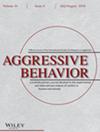Manipulation of Attention Allocation to Social Stimuli: Effects on Ambiguous Provocation Interpretation and Anger Responses
Abstract
Previous research has implicated delayed visual attention to relevant social cues as characteristic of aggressive youth and adults, suggesting that aggression may, in part, result from utilizing hostile schemas rather than available social information when interpreting ambiguous events. The current study used a manipulation-of-attention task to test the causal role of attentional biases in children's appraisal of ambiguous provocations. Sixty-six 4th- through 7th-grade children (30 boys; Mage = 11.5 years) viewed video clips of ambiguous provocation after being cued to maintain visual attention on either the provocateur or victim and answered questions measuring hostile intent attribution and expected anger of the victim. Data were also collected regarding the children's aggressive behavior and peer victimization. Results showed that directing attention to the provocateur when watching scenes of ambiguous physical provocation led to less hostile interpretations and lower anger scores, as compared to when attention was directed to the victim. Additional analyses suggested that this effect was specific to children who were high in physical peer victimization, particularly when they were also high in reactive aggression. This study has important implications for understanding how automatic processing of information contributes to the development of anger and aggression.

 求助内容:
求助内容: 应助结果提醒方式:
应助结果提醒方式:


